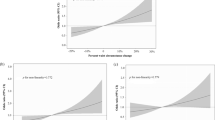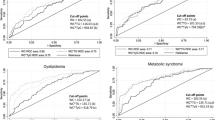Abstract
Background/Objectives:
This cohort study was conducted to evaluate the effect of waist change on metabolic syndrome (MetS) status and its parameters in 5720 participants, aged ⩾20 years, of the Tehran Lipid and Glucose Study who were followed up for a mean of 6.6 years.
Subjects/Methods:
We measured waist circumference (WC) and MetS parameters at baseline (phase I: 1999) and at follow-up (phase III: 2008), and assessed this relationship across five groups: waist loss (<−2.0 cm); waist stable (−2.0 to 2.9 cm); mild (3.0–5.9 cm); moderate (6.0–8.9 cm) and large (⩾9.0 cm) waist gain. MetS was defined according to the International Diabetes Federation criteria.
Results:
In phase I, the mean (s.d.) waist gain was 88.8 cm (11.7). Between phases I and III, the mean (s.d.) waist gain was 5 cm (7.9). There was 16% (95% confidence interval (95% CI): 13.6–18.4) age-adjusted incident MetS and for every centimeter of WC gained over 6.6 years, the risk of MetS increased by 10% (odds ratio (OR) 1.10; 95% CI: 1.09–1.12). Compared with a stable WC in both genders, ORs for MetS for different waist gain groups were as follows: mild (OR 2.3, 95% CI: 1.7–3.2); moderate (OR 3.5, 95% CI: 2.6–4.7) and large (OR 5.8, 95% CI: 4.5–7.6). Waist loss had a protective effect on MetS (OR 0.6, 95% CI: 0.4–0.9). Waist gain showed a detrimental effect on all parameters of MetS in both genders, except for high-density lipoprotein cholesterol and fasting blood sugar in women.
Conclusions:
Waist gain, even mild, was a risk factor of the development of MetS and its parameters. Intervention for reducing WC could be an effective strategy to decrease incident MetS.
This is a preview of subscription content, access via your institution
Access options
Subscribe to this journal
Receive 12 print issues and online access
$259.00 per year
only $21.58 per issue
Buy this article
- Purchase on Springer Link
- Instant access to full article PDF
Prices may be subject to local taxes which are calculated during checkout

Similar content being viewed by others
References
Ainsworth BE, Jacobs JR, Leon AS (1993). Validity and reliability of self-reported physical activity status: the Lipid Research Clinics questionnaire. Med Sci Sports Exerc 25, 92–98.
Alberti KG, Zimmet P, Shaw J (2005). IDF Epidemiology Task Force Consensus Group. The metabolic syndrome-a new worldwide definition. Lancet 366, 1059–1062.
Azizi F, Ghanbarian A, Momenan AA, Hadaegh F, Mirmiran P, Hedayati M et al. (2009). Prevention of non-communicable disease in a population in nutrition transition: Tehran Lipid and Glucose Study phase II. Trials 10, 5.
Azizi F, Rahmani M, Emami H, Madjid M (2000). Tehran Lipid and Glucose Study: rationale and design. CVD Prevent 3, 242–247.
Balkau B, Picard P, Vol S, Fezeu L, Eschwège E (2007). Consequences of change in waist circumference on cardiometabolic risk factors over 9 years: data from an Epidemiological Study on the Insulin Resistance Syndrome (DESIR). Diabetes Care 30, 1901–1903.
Bertin E, Nguyen P, Guenounou M, Durlach V, Potron G, Leutenegger M (2000). Plasma levels of tumor necrosis factor-alpha (TNF-alpha) are essentially dependent on visceral fat amount in type 2 diabetic patients. Diabetes Metab 26, 178–182.
Brochu M, Tchernof A, Turner A, Ades P, Poehlman E (2003). Is there a threshold of visceral fat loss that improves the metabolic profile in obese postmenopausal women? Metabolism 52, 599–604.
Cameron AJ, Boyko EJ, Sicree RA, Zimmet PZ, Söderberg S, Alberti KG et al. (2008). Central obesity as a precursor to the metabolic syndrome in the AusDiab study and Mauritius. Obesity (Silver Spring) 16, 2707–2716.
Carr DB, Utzschneider KM, Hull RL, Kodama K, Retzlaff BM, Brunzell JD et al. (2004). Intra-abdominal fat is a major determinant of the National Cholesterol Education Program Adult Treatment Panel III criteria for the metabolic syndrome. Diabetes 53, 2087–2094.
Chuang SY, Chou P, Hsu PF, Cheng HM, Tsai ST, Lin IF et al. (2006). Presence and progression of abdominal obesity are predictors of future high blood pressure and hypertension. Am J Hypertens 19, 788–795.
Dekker JM, Girman C, Rhodes T, Nijpels G, Stehouwer CD, Bouter LM et al. (2005). Metabolic syndrome and 10-year cardiovascular disease risk in the Hoorn Study. Circulation 112, 666–673.
Gómez-Ambrosi J, Pastor C, Salvador J, Silva C, Rotellar F, Gil MJ et al. (2007). Influence of waist circumference on the metabolic risk associated with impaired fasting glucose: effect of weight loss after gastric bypass. Obes Surg 17, 585–591.
Grievink L, Alberts JF, O’Niel J, Gerstenbluth I (2004). Waist circumference as a measurement of obesity in the Netherlands Antilles; associations with hypertension and diabetes mellitus. Eur J Clin Nutr 58, 1159–1165.
Han TS, McNeill G, Seidell JC, Lean ME (1997). Predicting intra-abdominal fatness from anthropometric measures: the influence of stature. Int J Obes Relat Metab Disord 21, 587–593.
Hayashi T, Boyko EJ, McNeely MJ, Leonetti DL, Kahn SE, Fujimoto WY (2008). Visceral adiposity, not abdominal subcutaneous fat area, is associated with an increase in future insulin resistance in Japanese Americans. Diabetes 57, 1269–1275.
Hirani V, Zaninotto P, Primatesta P (2008). Generalised and abdominal obesity and risk of diabetes, hypertension and hypertension-diabetes co-morbidity in England. Public Health Nutr 11, 521–527.
Hsin-Jen C, Chyi-Huey B, Wen-Ting Y, Hou-Chang C, Wen-Harn P (2006). Influence of metabolic syndrome and general obesity on the risk of ischemic stroke. Stroke 37, 1060–1064.
Klein S, Allison DB, Heymsfield SB, Kelley DE, Leibel RL, Nonas C et al. (2007). Association for Weight Management and Obesity Prevention; NAASO; Obesity Society; American Society for Nutrition; American Diabetes Association.Waist circumference and cardio metabolic risk: a consensus statement from shaping America's health: Association for Weight Management and Obesity Prevention; NAASO, the Obesity Society; the American Society for Nutrition; and the American Diabetes Association. Diabetes Care 30, 1647–1652.
Kershaw EE, Flier JS (2004). Adipose tissue as an endocrine organ. J Clin Endocrinol Metab 89, 2548–2556.
Liu SJ, Guo ZR, Hu XS, Wu M, Chen FM, Kang GD et al. (2008). Risks for type-2 diabetes associated with the metabolic syndrome and the interaction between impaired fasting glucose and other components of metabolic syndrome the study from Jiangsu, China of 5 years follow-up. Diabetes Res Clin Pract 81, 117–123.
Mayer-Davis EJ, Kirkner GJ, Karter AJ, Zaccaro DJ (2003). Metabolic predictors of 5-year change in weight and waist circumference in a triethnic population: the insulin resistance atherosclerosis study. Am J Epidemiol 157, 592–601.
Meigs JB, Rutter MK, Sullivan LM, Fox CS, D’Agostino Sr RB, Wilson PW (2007). Impact of insulin resistance on risk of type 2 diabetes and cardiovascular disease in people with metabolic syndrome. Diabetes Care 30, 1219–2125.
Menke A, Muntner P, Wildman RP, Reynolds K, He J (2007). Measures of adiposity and cardiovascular disease risk factors. Obesity (Silver Spring) 15, 785–795.
Nakamura H, Ito H, Egami Y, Kaji Y, Maruyama T, Koike G et al. (2008). Waist circumference is the main determinant of elevated C-reactive protein in metabolic syndrome. Diabetes Res Clin Pract 79, 330–336.
Nyamdorj R, Qiao Q, Söderberg S, Pitkäniemi JM, Zimmet PZ, Shaw JE et al. (2009). BMI compared with central obesity indicators as a predictor of diabetes incidence in Mauritius. Obesity (Silver Spring) 17, 342–348.
Palaniappan L, Carnethon MR, Wang Y, Hanley AJ, Fortmann SP, Haffner SM et al. (2004). Predictors of the incident metabolic syndrome in adults: the Insulin Resistance Atherosclerosis Study. Diabetes Care 27, 788–793.
Pettman TL, Buckley JD, Coates AM, Misan GM, Petkov J, Howe PR (2009). Prevalence and interrelationships between cardio-metabolic risk factors in abdominally obese individuals. Metab Syndr Relat Disord 24, 31–36.
Smith Jr SC, Haslam D (2007). Abdominal obesity, waist circumference and cardio-metabolic risk: awareness among primary care physicians, the general population and patients at risk–the Shape of the Nations survey. Curr Med Res Opin 23, 29–47.
Sone H, Tanaka S, Iimuro S, Oida K, Yamasaki Y, Ishibashi S et al. (2009). Waist circumference as a cardiovascular and metabolic risk in Japanese patients with type 2 diabetes. Obesity (Silver Spring) 17, 585–592.
Stolk RP, Suriyawongpaisal P, Aekplakorn W, Woodward M, Neal B (2005). Fat distribution is strongly associated with plasma glucose levels and diabetes in Thai adults-the InterASIA study. Diabetologia 48, 657–660.
van Harmelen V, Dicker A, Ryden M, Hauner H, Lonnqvist F, Naslund E et al. (2002). Increased lipolysis and decreased leptin production by human omental as compared with subcutaneous preadipocytes. Diabetes 51, 2029–2036.
World Health Organization (1998). Guideline for Controlling and Monitoring. The Tobacco Epidemic: Geneva.
Yatagai T, Nagasaka S, Taniguchi A, Fukushima M, Nakamura T, Kuroe A et al. (2003). Hypoadiponectinemia is associated with visceral fat accumulation and insulin resistance in Japanese men with type 2 diabetes mellitus. Metabolism 52, 1274–1278.
Acknowledgements
We thank the staff and participants in the TLGS study for their important contribution, and Mrs Nilufar Shiva for her assistance in manuscript preparation and language editing.
Author information
Authors and Affiliations
Corresponding author
Ethics declarations
Competing interests
The authors declare no conflict of interest.
Rights and permissions
About this article
Cite this article
Hosseinpanah, F., Barzin, M., Mirmiran, P. et al. Effect of changes in waist circumference on metabolic syndrome over a 6.6-year follow-up in Tehran. Eur J Clin Nutr 64, 879–886 (2010). https://doi.org/10.1038/ejcn.2010.79
Received:
Revised:
Accepted:
Published:
Issue Date:
DOI: https://doi.org/10.1038/ejcn.2010.79



